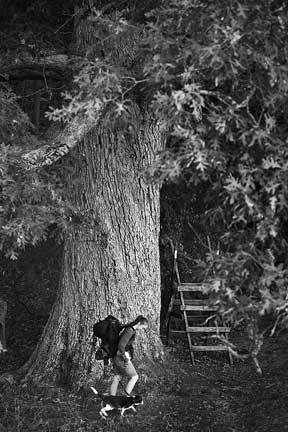Story by Maureen Halsema
As I scrambled down the hill along the Appalachian Trail in Craig County, I could see gargantuan branches protruding in every direction. I realized that I had found the Keffer Oak.
The massive branches spiraled around this centuries-old tree trunk covered with moss and snow. I stepped over a section of a rusted barbed wired fence, noticing sections that had been absorbed by the trunk of this impressive life force. It was bigger than I had imagined.
I craned my neck, staring up into the branches of this fantastical tree that seemed like it had been drawn from a storybook. The gnarly white oak is estimated to be 300 years old and over 18 feet in circumference. It’s one of the largest standing trees on the AT, the faded white blaze barely visible on the old bark.
“It serves as a sturdy representation of Virginia for all the thru-hikers who pass by on the trail each year,” Virginia Tech forestry professor Jeff Kirwan wrote in a new book, Remarkable Trees of Virginia.
Kirwan teamed up with garden writer and lecturer Nancy Ross Hugo and photographer Robert Llewellyn to write this book to showcase the state’s most special trees and to connect a new generation to its roots.
The trio published the book of nominated trees in September after four years of work. The Virginia Big Tree Program, funded by Trees Virginia (the state’s urban forestry council) and coordinated by Kirwan, provided the foundation from which the authors worked.
The program continually identifies and catalogs the state’s largest trees. These “champion trees” are determined by a formula using the tree’s circumference, height, and crown. When Kirwan first decided to update the state’s list of champion trees several years ago, he expected to find as many as 30 percent of the listed trees perished or gone. To his dismay, over half of the original 52 trees identified by the program were dead or severely injured. Sadly, approximately 25 percent of the landowners were not aware that they had champion trees on their property.
Virginia’s diversity among species of trees has traditionally ranked high in the national register of trees.
According to American Forests, which publishes the National Register of Big Trees, Virginia ranks fifth in the nation for champion trees. The state is home to 56 national champion trees, the largest of their species.
The Virginia Big Tree Program provided a starting point for the Remarkable Trees of Virginia book project. The authors hope that the book will help increase awareness and appreciation for trees, particularly within local communities. “We’re trying to emphasize the values of trees and the services they provide,” Kirwan said.
“Trees, to me, are the highest and best representations of nature,” Hugo explained. “I’m fascinated by them. After we looked at the Virginia Big Tree Program register, we envisioned a book that would not only unveil champion trees, but would also honor trees that were noteworthy for their age, beauty, history and community significance.”
The book project was sponsored by Virginia Tech’s forestry and fisheries and wildlife sciences departments, Virginia Forestry Education Foundation, Bartlett Tree Experts, Robert H. Smith Family Foundation, Peck Family Fund, and Trees Virginia.
Kirwan grew up in a rural section of Maryland that has since lost its trees to the growing metropolitan areas of southeast Washington, D.C. This urbanization of forestland made him realize the true value of trees. “Trees connect us with our roots,” Kirwan said. “Trees that are 300 or 400 years old have been witnesses to every single event of our country’s history.”
Four different people nominated one particular tree, the Emancipation Oak. Though it is not the largest of its kind, this remarkable tree resides on the campus of Hampton University. The Emancipation Proclamation was read for the first time in the South under this noteworthy oak by educator Mary Peake in 1863. Peake later taught some of the first lessons to newly freed men and women beneath this same tree. The National Geographic Society designated this oak as one of the 10 Great Trees of the World because it is witness to one of the most significant moments in our nation’s history.
The Remarkable Trees of Virginia book, as well as the project’s website, lists every nominated tree and the person who nominated it, regardless of whether or not that tree made the book cut. A major focus of the book project was to incorporate children in the nomination process. The authors involved scout troops, 4-H groups and schools.
“The project encouraged children to connect not just to trees in general but to specific trees,” Hugo said. “We wanted them to look carefully at the trees in their neighborhoods, so that they would begin to feel connected to specific trees and their habitats, not just to anonymous nature.”
Over 1,000 Virginia trees were nominated for possible inclusion in the book, which will feature the stories and photographs of 100 of Virginia’s most special trees. “We have chapters of big trees, historic trees, community trees, tree places, unique or unusual trees, and noteworthy specimens,” Kirwan noted.
More Stories

Leave a comment
Your email address will not be published. Required fields are marked *






Leave a Comment